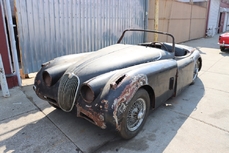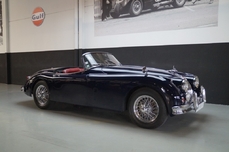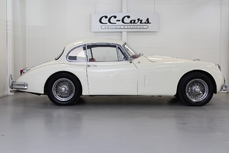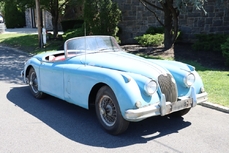Jaguar XK150 150S Roadster 1959
General description :
When Jaguar unveiled the XK150 in 1957, it marked the most significant evolution of the legendary XK series since the XK120 first appeared in 1948. In mechanical terms, the new 150 was very similar to the outgoing 140, with independent front suspension, Salisbury rear axle, and rack and pinion steering. New for the 150, however, was the fitment of Dunlop four-wheel disc brakes, which had been pioneered by the C-Type and perfected on the D-Type at Le Mans. The most significant changes were to the styling, with a taller and wider body to allow for a roomier cockpit and give a fresh look heading into the 1960s. In keeping with tradition, the XK150 was available as an open two-seat roadster, drophead coupe or closed fixed-head coupe. Power continued to come from the 3.4-liter version of the XK twin-cam inline six, fitted with twin S.U. carburetors in standard form.
At first, it seemed that the XK150 got off to a rough start. A factory fire in February 1957 delayed production and the marginally heavier coachwork made the standard models slightly slower than the XK140, thereby disappointing buyers. However, Jaguar quickly responded by adding the Special Equipment package which added twenty horsepower to the base model. That was followed by the optional “S” package of 1958, with a trio of 2-inch SU carbs and a straight-port cylinder head to bump output to a very healthy 250 horsepower. Only the last of the line 3.8-liter S would make more power. Buyers responded well to the modernized styling, as well as the improved comfort and performance, particularly from the S.E. and S models. Sales were up slightly over the XK140. Ultimately, the XK150 proved to be an excellent swansong to the legendary XK line, setting the stage for the arrival of Jaguar’s next sensational sports car, the E-Type.
We are delighted to offer this truly outstanding, freshly restored 1958 Jaguar XK150 S OTS roadster. This Jaguar is a documented, factory built XK150 S, first delivered via a dealer in Atlanta, Georgia. It is finished as original in white over a red interior and black hood and highly optioned from new in “S” specification which included triple SU carburetors and a specially-developed cylinder head. Backing the 3.4-liter engine was a four-speed manual gearbox with Laycock de Normanville overdrive. Standard equipment included leather trim, Smiths heater, chrome wire wheels, and new for the OTS, roll-up side windows (replacing the XK120 and 140’s removable side curtains).
The first owner was Robert West of Athens, Georgia. Early in the car’s life, someone (believed to be Mr. West) drove the XK150 from Georgia to Detroit, Michigan. While in Detroit, the original engine was damaged, and the car subsequently parked up in a gas station. The second owner acquired the Jaguar in the early 1970s, putting it in his garage in hopes of returning it to the road. It seems that never happened, as in the early 2000s, this car was discovered, still in remarkably original and unrestored condition, by brothers Gary and Jim Kakuska of JK Restorations in Oswego, IL. Gary and Jim are highly respected Jaguar specialists, and they bought the car with the idea of restoring it for themselves, but ultimately sold it to one of their best clients who then entrusted them with the comprehensive nut-and-bolt restoration.
As they began disassembly, Gary and Jim noted that the car showed approximately 2,000 miles on the odometer. Closer inspection of the body, interior, and drivetrain revealed this was very likely the original mileage as the car was found to be remarkably intact beneath the years of dust that had accumulated while in storage. As a result, JK was able to restore and reuse a tremendous amount of the original components and fittings.
The restoration was completed in approximately 2015, and it presents in stunning condition in crisp white over red, displaying outstanding body fit and alignment. Remarkably, it is reported that every panel on the car is original, with only some very minor repairs required to correct some light corrosion. Paint quality is exquisite as well, and the car sits on beautiful chrome Dunlop wire wheels with blackwall Vredestein radial tires. The bumpers, lights, grille, and trim are original to this car and restored to a high standard.
The cockpit has been refurbished to the same specification as it was first delivered; with red Connolly hides and matching Wilton wool carpets, all presented in beautiful condition. The leather seats remain taut and show virtually no use since being restored. The factory switchgear and instruments were painstakingly rebuilt to retain originality. Black Haartz canvas is fitted to the top as per factory spec, and the boot has been refurbished with correct Hardura lining. The factory-supplied jack, grease gun, ratcheting jack handle, and toolkit is included.
JK Restorations meticulously rebuilt every component of this car, making subtle improvements when necessary in the name of longevity and reliability. A 3.8-liter block replaces the original 3.4-liter unit, topped with the original cylinder head and triple-SU carb setup. The engine is backed with a modern, all-synchro 5-speed Tremec gearbox. The original rear differential was rebuilt with new clutch packs and the factory 4.09:1 ratio retained, so the car’s road manners remain very authentic while allowing for effortless shifting and proven reliability. It should be noted that the original, matching-numbers block, gearbox, and overdrive unit are available (and said to be easily repairable) and will be included in the sale. Brake calipers and cylinders were fully restored and sleeved in stainless to prevent corrosion. The Kakuskas painstakingly restored the electrical system, retaining the original major components while updating some items such as LED tail lights and a roller bearing distributor. The undercarriage is a finely detailed as the engine bay, revealing the level of care that went into this project.
With its meticulous restoration by highly respected marque experts, this is a genuinely exquisite XK150 S in highly desirable original specification. A host of carefully judged and executed improvements make it ideally suited for regular enjoyment on tours and rallies while remaining beautiful enough for the show field.
https://hymanltd.com/vehicles/6255
1959 Jaguar XK150 150S Roadster is listed sold on ClassicDigest in St. Louis by Mark Hyman for $225000.
Car Facts
Car type : Car Make : Jaguar Model : XK150 Model Version : 150S Roadster Engine size : 0.0 Model Year : 1959 Sub type : Convertible Location : Missouri
Sold
Seller Information
Sold
People who viewed this Jaguar XK150 also viewed similar Jaguar listed at ClassicDigest
Other cars listed for sale by this dealer
About Jaguar
Ah, the story of Jaguar, from its early days as the SS Cars Ltd. to its pinnacle with the D-type, and the street-going evolution in the form of the iconic E-type. There's something quintessentially British about this tale, and I'll narrate it as a British journalist might.In the Beginnings:
Our journey into the world of Jaguar begins in the 1930s, when a company known as SS Cars Ltd. emerged. Despite the unfortunate coincidence of their initials with the rising political tensions in Europe, they started producing stylish and performance-oriented cars. The SS 100, introduced in 1936, was a symbol of elegance and speed, setting the stage for what would become Jaguar.
The Birth of Jaguar:
As the shadows of World War II loomed, SS Cars Ltd. wisely decided to disassociate themselves from the SS initials. Thus, in 1945, they officially became Jaguar Cars Ltd., a name that would soon be synonymous with British luxury and performance.
The XK Series:
Jaguar's post-war era brought us the XK 120, a true sensation in 1948. With its sleek design and a powerful 3.4-liter inline-six engine, it became the world's fastest production car. The XK 120 was the blueprint for what lay ahead – Jaguars that blended style with speed in a uniquely British fashion.
The D-type Dominance:
Then came the D-type, a true racing legend. Introduced in 1954, it won Le Mans three times in the 1950s, showcasing Jaguar's engineering prowess. With its innovative monocoque construction and the iconic fin at the back, the D-type was the apex of Jaguar's motorsport success.
The E-type Emergence:
But the true turning point arrived in 1961 with the introduction of the E-type, often described by Enzo Ferrari as "the most beautiful car ever made." Its long bonnet, curvaceous body, and a 3.8-liter engine delivering exhilarating performance made it an instant classic. The E-type was not just a car; it was a work of art on wheels, and it could hit 150 mph on the road.
Street and Racing Success:
The E-type's beauty was matched by its capability on the track. The lightweight E-types were particularly successful in various racing events, cementing Jaguar's reputation as a force to be reckoned with in motorsport.
The Age of Refinement:
As we delve deeper into the Jaguar story, we find that the 1950s and 1960s were an age of refinement and expansion. Alongside the magnificent D-type and the E-type's iconic emergence, Jaguar introduced models that further solidified its reputation for luxury and performance.
The MK2:
In the late 1950s, Jaguar unveiled the MK2, a sports sedan that combined elegance with power. This sleek four-door saloon was a favorite of bank robbers and law enforcement alike, thanks to its exceptional speed and handling. The MK2 was a symbol of Jaguar's ability to blend sophistication with performance and had a successful racing career as well.
The XJ6:
Fast forward to 1968, and Jaguar launched a car that would define luxury saloons for decades to come – the XJ6. It was a masterpiece of engineering and design, featuring a smooth inline-six engine, independent rear suspension, and a spacious, beautifully appointed interior. The XJ6 was a symbol of British elegance and provided a ride so smooth that it seemed to glide over the road. It became the flagship model for Jaguar and set the standard for luxury saloons, showcasing a level of refinement that left competitors in awe.
The Blend of Classic and Modern:
While the MK2 and XJ6 represented the evolution of Jaguar's saloon cars, they maintained the brand's commitment to performance and luxury. These cars didn't just belong on the racetrack; they were equally at home cruising down the grand boulevards or gliding through the English countryside.
The Challenges of Change:
However, as the 1970s arrived, Jaguar, like many British automakers, faced financial challenges and changes in ownership. The British Leyland era brought both opportunities and struggles, as the brand navigated through various mergers and transitions.
Nevertheless, the legacy of the MK2 and XJ6, along with the D-type and E-type, continues to define Jaguar as a manufacturer that combines timeless elegance with a spirit of performance. These classic models, whether driven on winding roads or parked as collectors' treasures, serve as a testament to Jaguar's enduring presence in the world of automotive excellence.
The Jaguar story, from its early days as SS Cars Ltd. to the creation of automotive icons like the E-type, MK2, and XJ6, is a journey that reflects the very essence of British motoring – a blend of luxury, power, and style that continues to captivate enthusiasts and connoisseurs alike.











